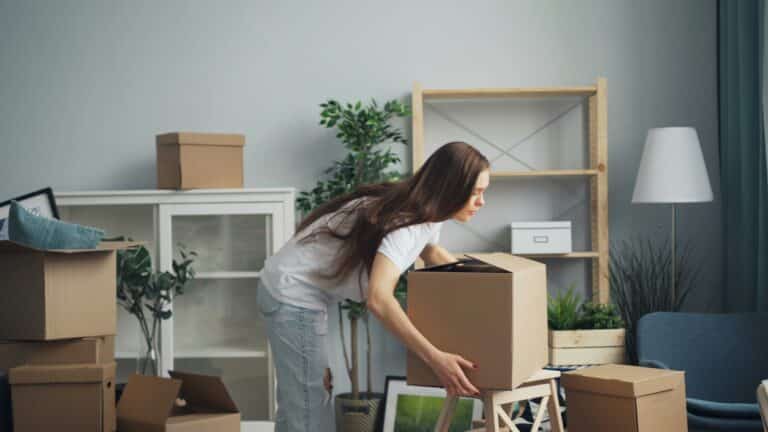In our last article, we explained how your home, even if it looks tidy, can evolve to give you a sense of invisible weight as it becomes disorganised over time. If you missed it, you can go back and read it here: Why you feel frustration with your home, even when it’s tidy
In this article, we’re going to explain how organising helps to solve that problem.
But first, we need to clarify a few things.
What actually is organising?
There’s a strong chance (particularly as you’re here!), that you have some idea of what organising is all about. You might have seen a Netflix or BBC programme, caught the odd reel on social media, or read about it in a lifestyle magazine.
Unless you know or have spoken to someone who’s had their home organised, there’s a chance you’ll think about organising in one of two ways:
- It’s for people dealing with a massive overwhelm of stuff which is having a serious impact on their lives at home, or
- It’s about making things look pretty with baskets and boxes and rainbowed lego
The reality is, most organising projects look very little like either. The vast majority of our clients definitely aren’t A, and they definitely don’t have time for B!
What problem does organising solve?
We love a beautifully organised space and the challenge of a really good sort out more than most, but for most people, that’s not the goal.
Here’s what they actually need:
- They need to be able to tidy up quickly
“I wish we didn’t have to spend so much time tidying, or that someone else would do it.” - They need things to stay tidy(ish) for longer
“I wish I didn’t have to keep thinking about this.” - They need it done and to not think about those messy spaces any more
“I just want to enjoy the time I have at home, not spend so much time thinking about and sorting everything out.”
Solving these problems doesn’t have anything to do with rainbows or throwing everything away (don’t worry, you can do that after!), and it’s much more than just having a good tidy up; it’s about organisation.
What does the act of organising involve?
The good news is, organising your home can be broken down into three simple parts.
1. Finding the right balance of stuff v. storage
An organised home has a good balance of stuff to storage. No cupboard, shelf or drawer is too full.
Put simply, you’re aiming for about 80:20. 80% stuff with about 20% free space. This is the magic ratio to allow you to use a space easily (nothing’s going to fall out when you move something) and allow for new things to be added without immediately having to get rid of others.
2. Making sure things are where they should be
You have storage, but where you choose to put things is what really matters.
By organising a space, rather than just putting things away, you’re creating a layout which makes it easier for your entire family to find things and to tidy up. If things are in a logical and intuitive place they’ll never get lost and no one has to ask you where they go.
Have you ever forgotten where you’ve put your toothbrush? No, because you keep it by the sink where you use it and when you finish with it, it’s completely logical and easy to put it back again. You’d never dream of putting it in a random drawer.
You’re aiming for that experience with everything in your home.
3. Having a simple approach for new things coming in
New things come into our homes all the time and no home will stay tidy if that’s ignored.
Organising creates a way to manage this in-flow. Firstly by creating that layout we just talked about. By defining what goes where, you have easy, visual prompts when one part is becoming overloaded and you’re in danger of losing the 20% buffer of free space.
If the bookshelf is full, and you have more that don’t fit, you either need to get rid of a few, or add more bookshelves.
Secondly, organising adds steps which make managing your belongings easier. Simple routines and structures that support the flow of new coming in and old going out.
What does this mean for your home?
By organising your home properly, it means you don’t have to put up with the frustration any more, and you can be one of those people with the clear kitchen island. Once you have the right balance of stuff, space and systems that work for you, you’ll have way more time and headspace to actually enjoy your time at home.
But what if I don’t have time, or know where to start?
All good questions!
The truth is, with a bit of forethought and planning, you can organise at least part of your home yourself. But here’s the thing, it’s your home, it’s not your job and you’re busy.
In the same way, you could (probably!), plumb in a new tap, or repaint your hallway, given enough time and some instruction. And you would probably make a half-decent fist of it.
But in reality, that’s why professional home organisers exist. Hiring a professional means you can get organised quickly and properly, and focus on enjoying the result.
What if things change?
Another very good question!
The most common motivations for getting organised are from a life change. Whether it’s a new baby, a move, a renovation or the kids growing up (or moving out!). In our next article, we’ll talk about maintenance, and when and how changes might mean you need to re-assess things.



